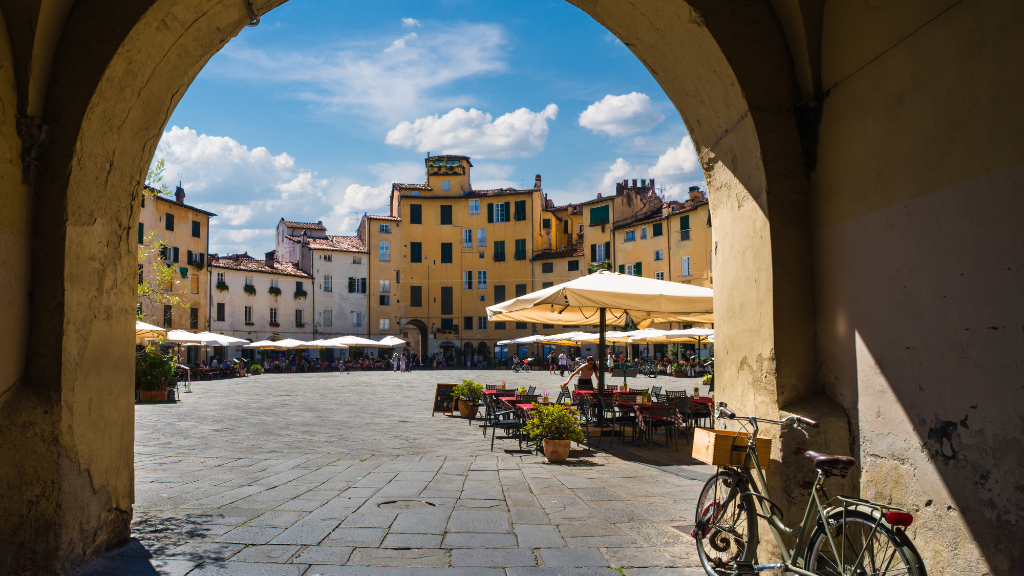I love Tuscany and, above all, Lucca. I’ve always loved what’s far away, different, and adventurous. I can’t stop arranging overseas trips and new challenges, but because of my parents’ work before and my own now, I’m stuck in the Cinque Terre area for several months a year, and I can only move around to visit the surroundings.
Among these short-distance daily trips, Lucca has always had a special place in my heart, and I can not stay away from her; it’s a Lady (!) for too long.

Lucca is like a candy box in northern Tuscany
Lucca is like a candy box or a tiny wedding favour Italian people use to offer their guests as a souvenir—but a very cool one, not one of those what-am-I-supposed-to-do-with-this-weird-sad-souvenir ones!
So, to me, Lucca is like a small jewel perfectly enclosed inside his chest: the kilometres of the city walls that surround it and still protect it from the outside world and somehow from reality.
It is from these walls that I usually begin my afternoons in the city. Once I pass the Door of San Pietro, I reach the walls, and, as in Maria Luisa of Bourbon’s plans, I start walking along this beautiful upper boulevard that separates the regular daily life from the beauty of the old town, with its churches dotted with colourful marbles, the swarm of workshops and traditional restaurants, its gardens and its towers that as a kid I could not wait to climb.
Along the wall, you can meet the human species as a whole … people like me who wander taking pictures and looking a bit lost, runners and sporty men and women, fancy ladies walking their dogs, people loudly chatting on their mobiles, lovers … in short, on the walls of Lucca there’s a whole world.
In general, I only walk downtown when something strikes my eye, often a tile roof that intrigues me, or when the urge to visit over and over a church rather than a square catches me or again when I notice a door or a window deserving a shot. And to tell the truth, Lucca is filled with details deserving one!

What to visit in Lucca
Among the monuments you shouldn’t miss is the impressive Guinigi Tower, with its magnificent roof garden dominated by beautiful oak trees, a symbol of rebirth. As a child, it was my favourite stop!
Another local beauty is the Tower of the Hours, which takes its name from the town’s first clock bell, installed here in 1390. Over the centuries, it has been improved several times, until 1752, when the Republic of Lucca commissioned a new and modern clock from Swiss watchmaker Simon, who worked with the Lucca one Caturegli. New bells were also cast, and they were very peculiar as they rang the Roman way, meaning from one to six as per the hours, while two smaller bells played the quarters. The beautiful hand-wound mechanism is visible once you reach the top of the tower. In short, it is a tower for watch lovers!

By purchasing the combined ticket at 6 €, in addition to the towers, you can also visit the Botanical Gardens of Maria Luisa of Bourbon, which reopened in 1965. There’s a lovely library inside it, and I also like the greenhouses with the herbaria.
Another main attraction in Lucca is its churches, and it is said that there were over a hundred in the Renaissance! The Basilica of San Frediano is my favourite. The building we see today results from several reconstructions, from the first one dating to the second half of the sixth century, under St. Frediano, whose body is kept in the crypt. The last changes were made in the thirteenth century, with the mosaic construction on the facade that enchants passersby.

The Cathedral of St. Martin is magnificent: its polychrome columns have tourists losing track of time. The entrance—once used to accommodate benches of changers dealing with the pilgrims stopping here along the Via Francigena—and the bell tower are pure beauty, which continues inside with the Madonna and Child Enthroned with Saints by Ghirlandaio.

However, the icon of Lucca is the Amphitheater Square, which is located precisely on the remains of a Roman elliptical amphitheatre from the second century. In the Middle Ages, it was transformed into a square to host gunpowder stores, prisons, commercial warehouses, and salt storage. I would have loved to see it then!

In the nineteenth century, the Lucchese architect Nottolini demolished these buildings to become the market square and then moved to the Carmel Market. Today, the Amphitheatre Square is a tourist centre and a delight! In its centre, there’s a tile bearing the engraving of a cross to mark the intersection of the four doors.

Perhaps less busy with tourists, but my passion is the native house of Giacomo Puccini, now a museum open to the public. The composer lived here until he moved to Milan, where he began his career, and nothing has changed in this little apartment on the second floor. Maybe it is because I love opera, but I always feel better looking at his photos, letters, autograph scores, notes, or Steinway. I’m here, and I imagine lives and worlds that always make me dream … a little bit of what happens when I visit Sant’ Agata. To learn more about this museum, I suggest you check their website.

Finally, a treat for the most curious and history lovers: did you know that a guillotine stands on the lawn in front of the Door of San Donato? This dreadful machine stood there until the summer of 1845, during the last execution of this kind on Italian territory. The homeland of the guillotine carried it on until 1977!
Also, Lucca is home to many festivals, including the fantastic and imaginative Lucca Comics, but I’ll tell you about it again because it deserves its own space!










